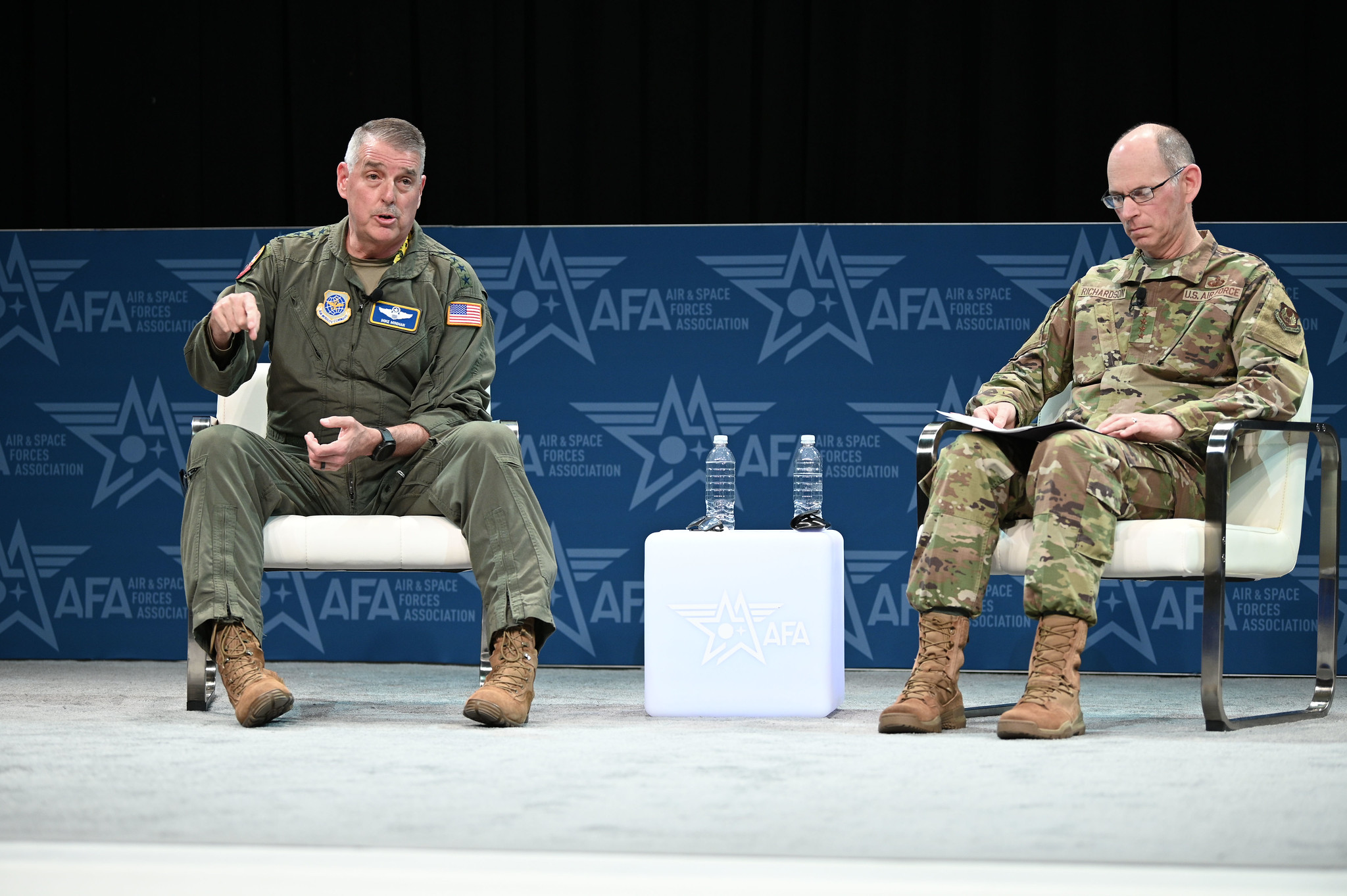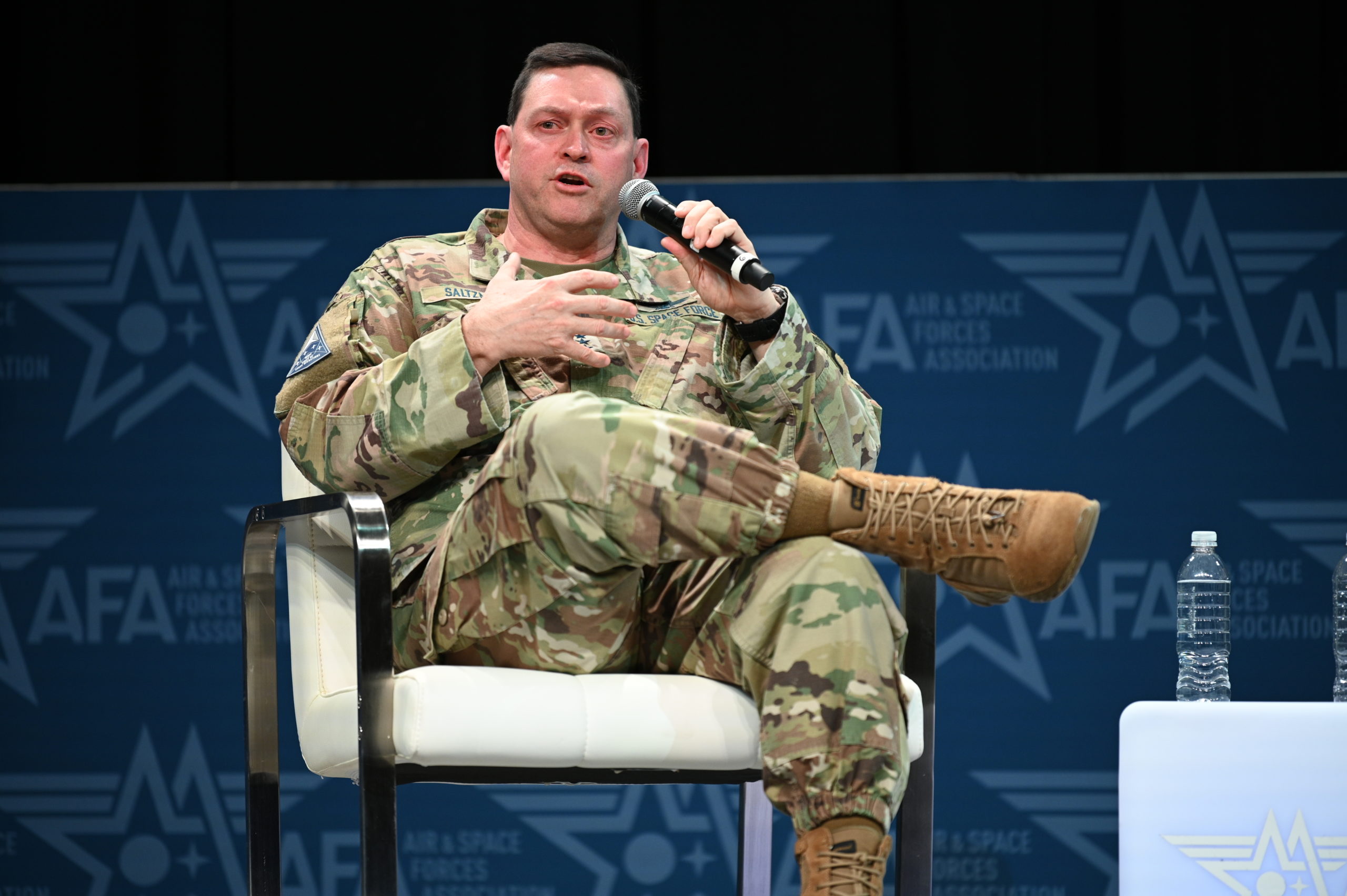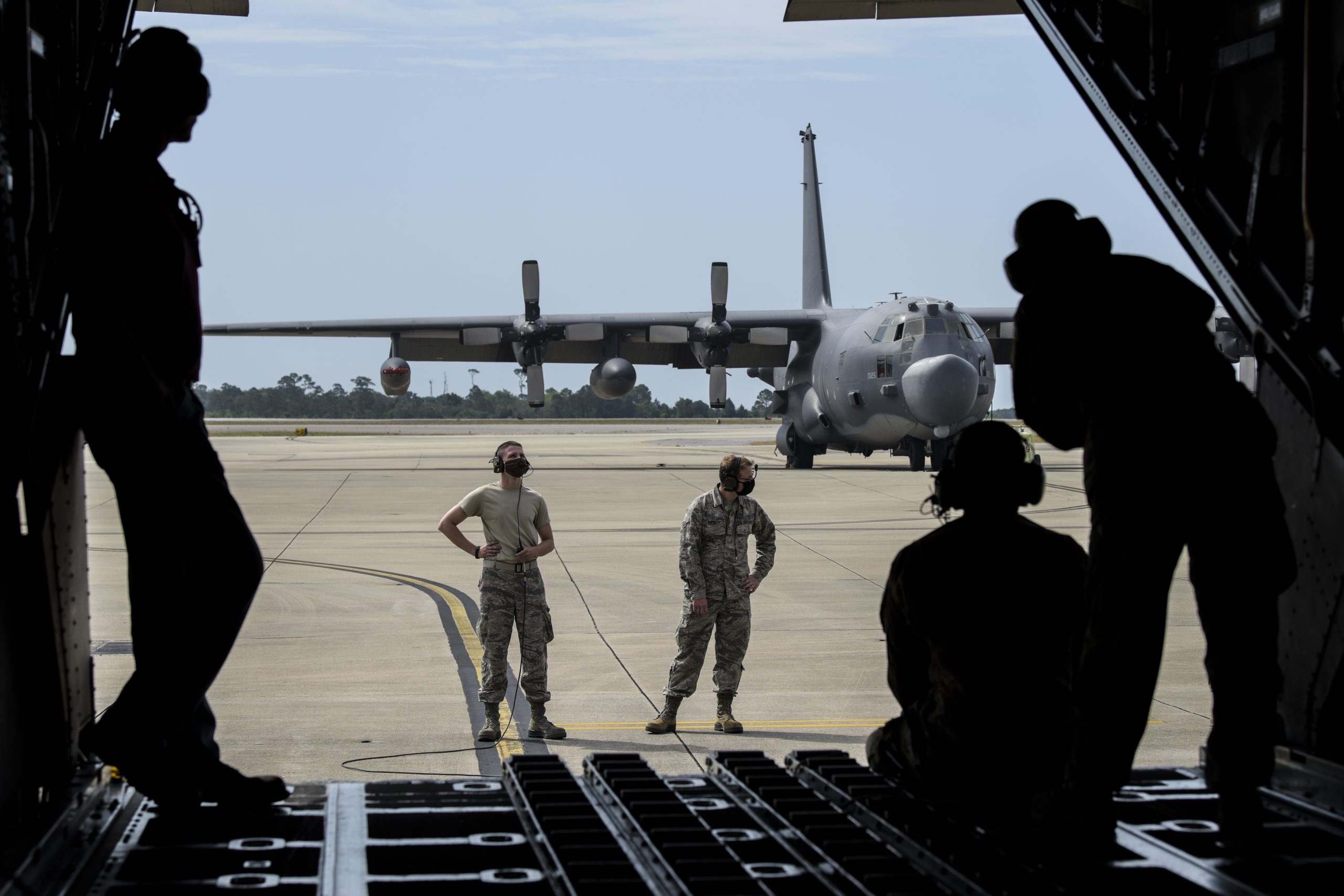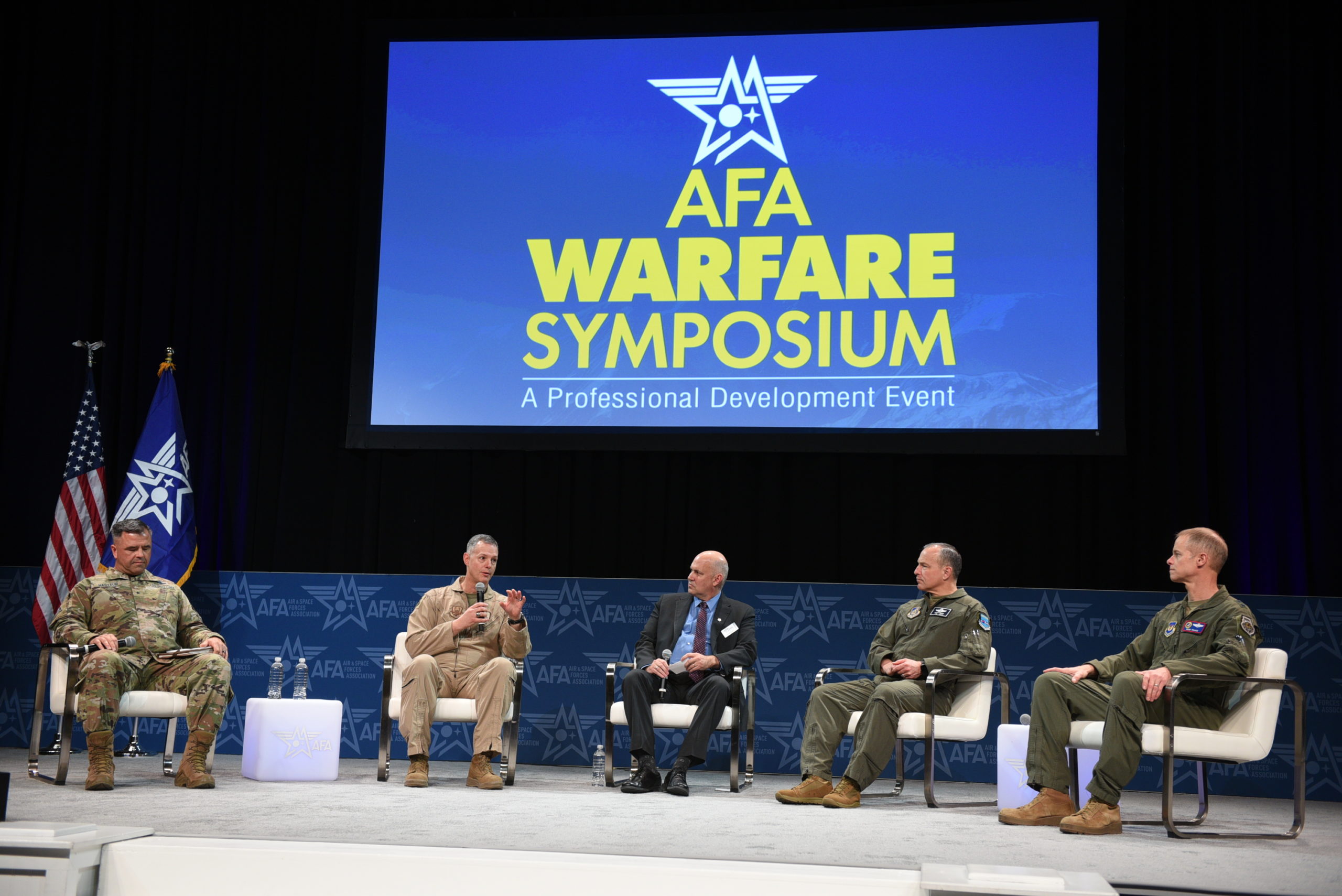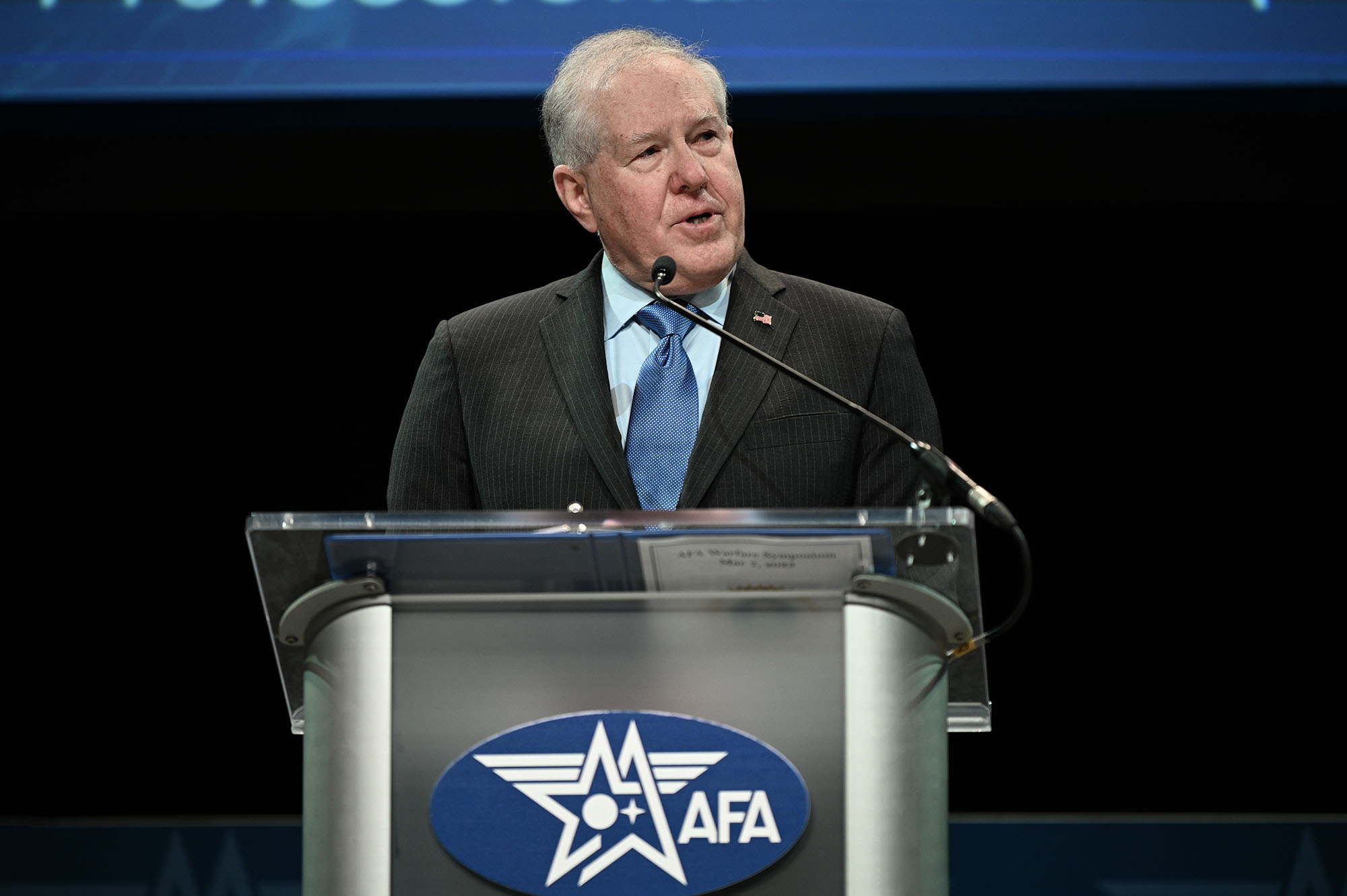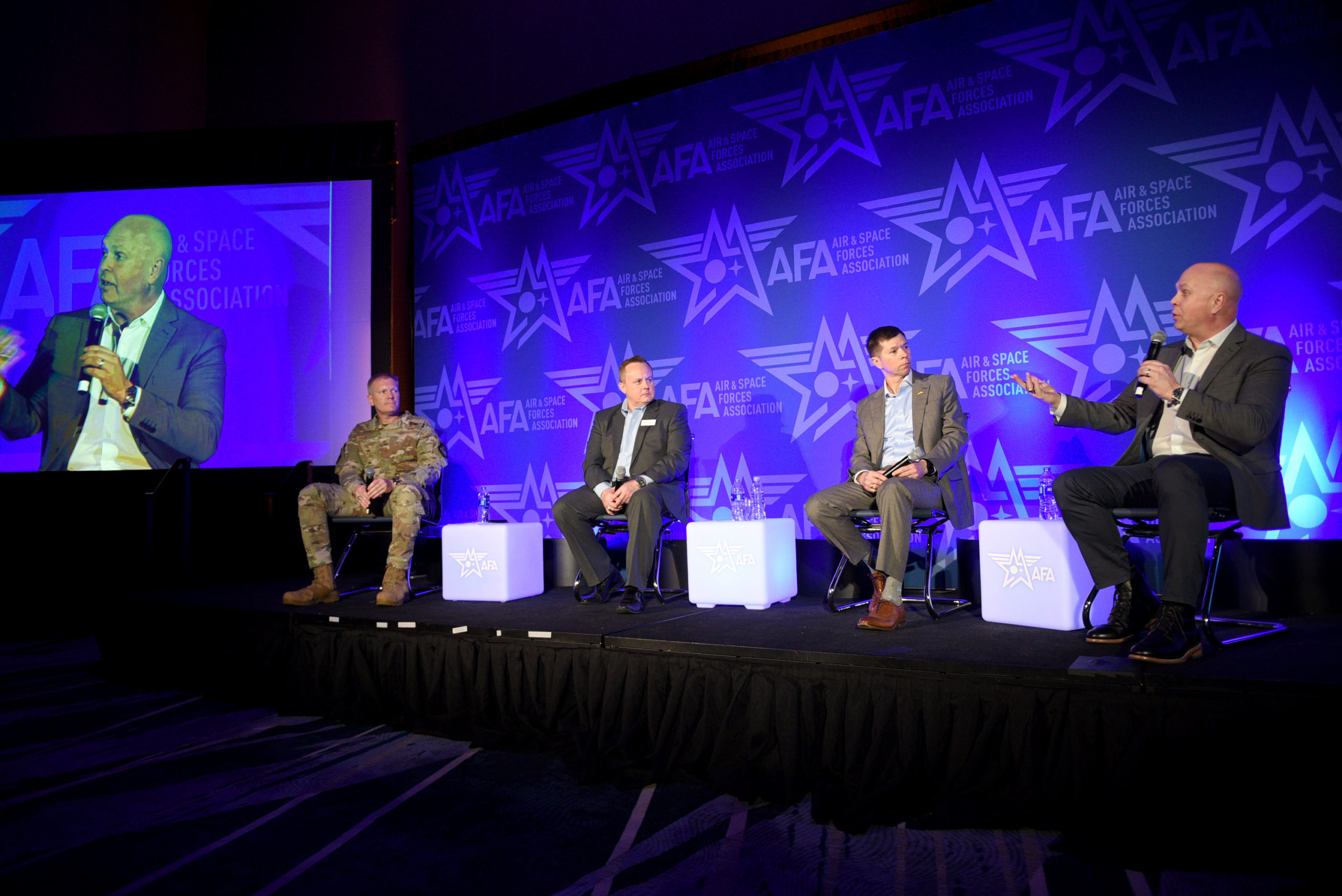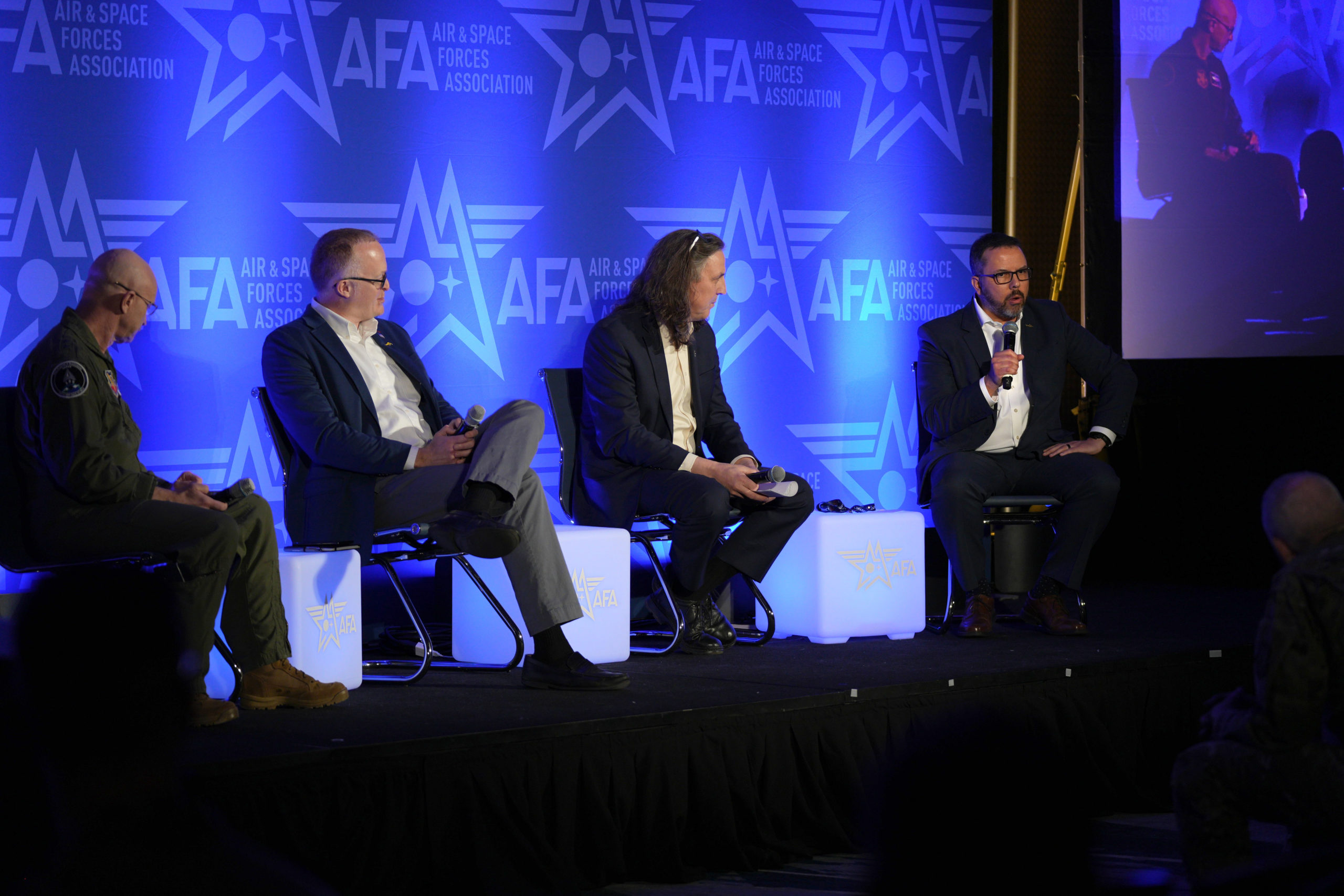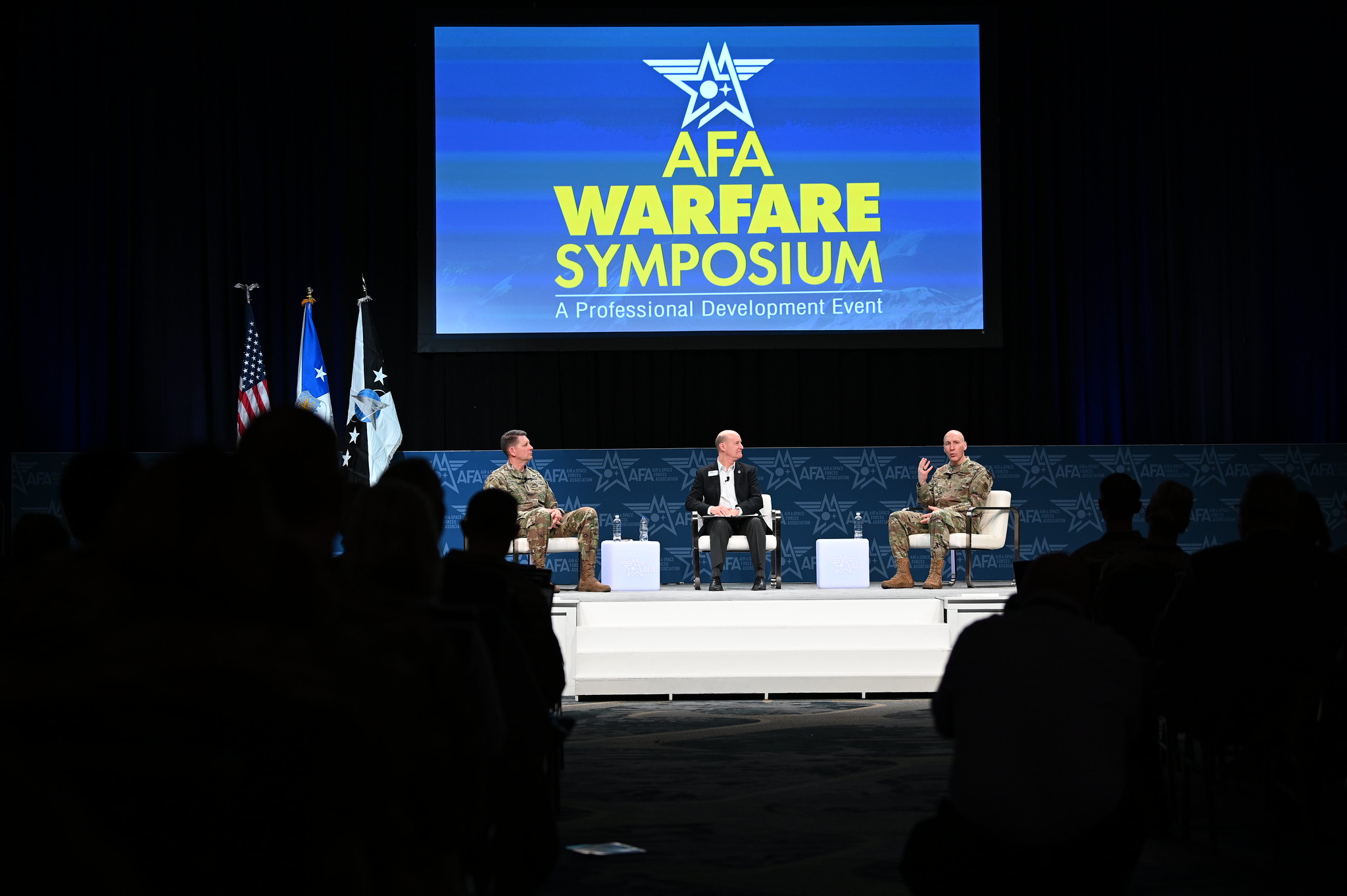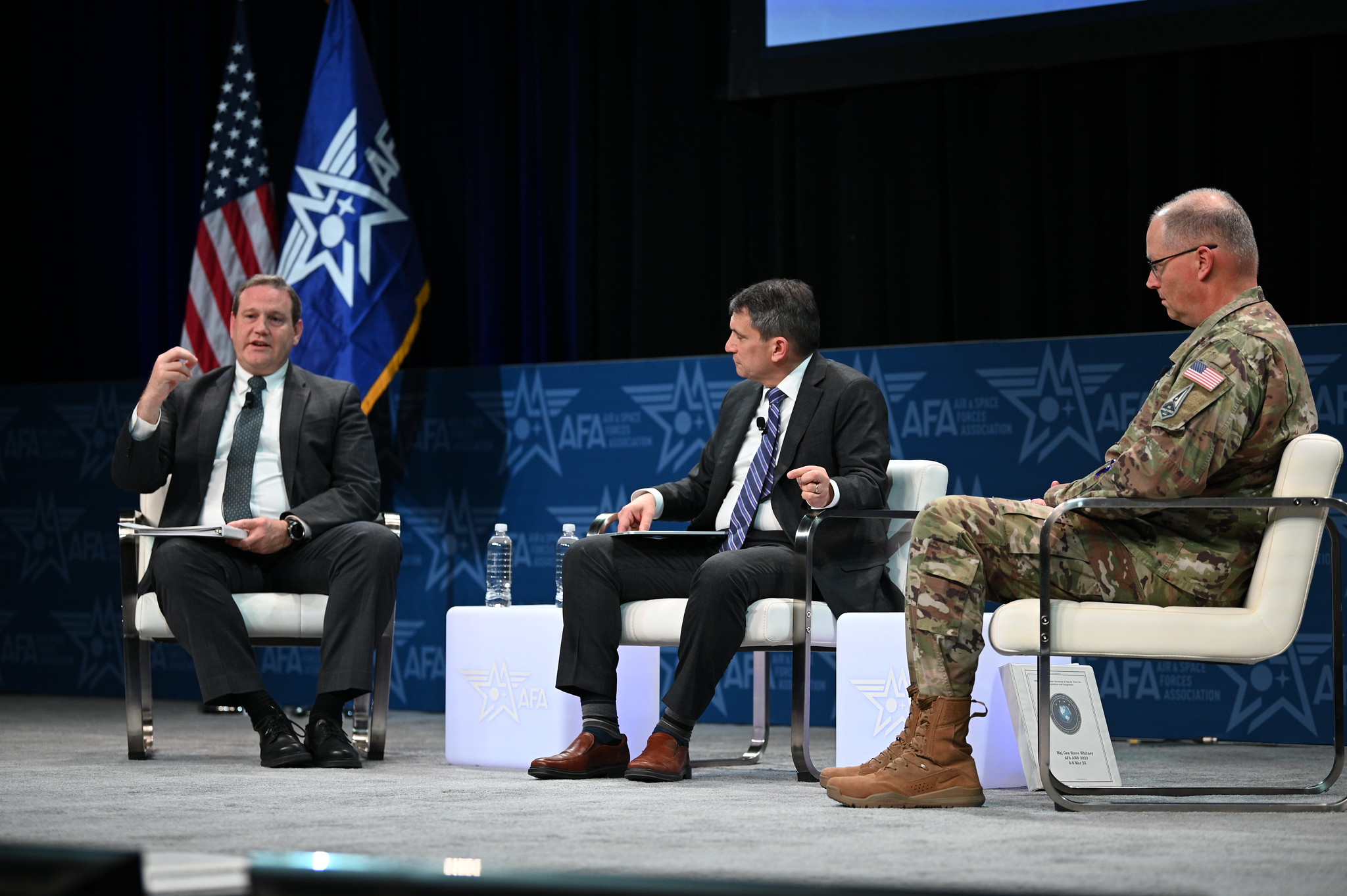The AFA Warfare Symposium hosted a session called “Logistics on the Attack: The Build Up and the Delivery” on March 7, 2023. The panel featured Gen. Mike Minihan, Commander, Air Mobility Command and Gen. Duke Richardson, Commander, Air Force Materiel Command. RAF ACDR Jez Attridge was the session’s moderator. Watch the video or read the transcript below.
Voiceover:
Please direct your attention to the stage and welcome our moderator, Royal Air Force Air Commodore Jez Attridge.
RAF ACDR Jez Attridge:
Sirs, ma’ams, ladies and gentlemen, welcome back. I am Air Commodore Jez Attridge, the British Air and Space Attache, and I oversee the RAF through all Air Force personnel here in the United States with US Space Force and the US Air Force from Hickam Air Force Base right the way through to Pentagon, flying the T-38 to the F-22. I’ve been very fortunate to be here for the last two years. For those of you at home on the online platform, there is a button you can press which will bring up close caption so you can understand what I’m saying. For those of you here in the Aurora room, I apologize, I’m speaking the King’s English, so I will speak slowly for you.
Now, unfortunately, I go home this summer after three years, but I’ll be hosting a party in Washington D.C. and I’d like to extend an invitation to all of you to come along to that. It’s on a British national holiday. It’s the 3rd of July. We call it Dependence Day, and at midnight we’ll bring the Union Jack down when the Stars and Stripes goes up to the national anthem as we celebrate the glorious withdrawal. So I hope to see you there.
Now, General Omar Bradley famously said, “Professionals talk logistics, amateurs talk tactics.” So it’s good to see all the amateurs have left and I’m left with the professionals because today we’re going to talk about logistics on the attack, the buildup, and delivery. Now, logistics, some used to say that was boring. Who would’ve thought Vladimir Putin would make it so interesting and actually showing sharp relief how much we need a good logistic plan? Because he has shown us really well what it looks like when it goes wrong and the buildup and delivery doesn’t account for plan A or for plan B. It’s probably too early to draw any real lessons from Ukraine, but it has highlighted areas that should be noted when considering how to keep a combat force viable. Under the heading Buildup, how do we get stockpiles of material right against the backdrop of post-Cold War assumptions and an industrial based size for the last war?
Russia has made it look very difficult on a European theater with plenty of roads in a relatively small distance between the border and Kiev. What about if we raise it from high school to varsity level and consider the Pacific, vast distances and fewer areas to use the supply nodes, all potentially during a period of competition? So, it’s fair to say that if the focus is China, China, China, then in order to deliver credible conventional deterrence, you should be going to sleep at night thinking about logistics, logistics, logistics. Secretary Kendall’s Operational Imperative Five is defining optimized resilient basing, sustainment and comms in a contested environment. This underlines the buildup and sustainment of logistics, and it’s my great pleasure to introduce the two MatCom generals pivotal to the successful deliveries of these capabilities, General Duke Richardson, Commander of Air Force Materiel Command and General Mike Minihan, Commander of Air Mobility Commands. Please join me in a round of applause.
General Richardson commands 89,000 personnel and oversees a budget of $72 billion annually. He is responsible for, among several other significant tasks, the sustainment and mission support of virtually every major air force weapon system. And you would’ve heard Chief Brown say this morning, “To provide logistics under attack, we need rapid global mobility.” The man responsible for that small task is General Mike Minihan. A 10-year veteran of the Pacific Theater, serving INDOPACOM, PACAF, the Pacific Forces career, and he’s responsible for transporting the material at the speed of relevance, whether in contested or uncontested airspace. I should also mention the incredible performance of his organization during the challenging drawdown in Afghanistan and the NEO that followed, and of course, the role of both organizations in providing enduring support to Ukraine. Ladies and gentlemen, would you show your support for the brave Ukrainians as they’re fighting now? Slava Ukraini. So, General Richardson, can I start with you, sir, please?
Gen. Duke Richardson:
Yes, absolutely.
RAF ACDR Jez Attridge:
So we’ve gone from countering violent extremists to considering fights against near peers to now peers, rather. Could you talk to us about the most pressing concerns within AFMC, in order to integrate across the logistics enterprise?
Gen. Duke Richardson:
I can. So, I would say … let me start at a broad sense. So, one of the things that we’re charged to do in Air Force Material Command that the secretary and the chief are both charged to do is not just deliver, but deliver integrated capabilities. Normally when you think about integrated capabilities, you’re really thinking about capabilities that are integrated with other capabilities, like a data link being able to pass information between platforms. In this context, it actually means something slightly different and I’d like to talk about that a little bit today.
So, the first charge that I’ve been given is to deliver integrated capabilities. What we’re doing, and Secretary Kendall mentioned this morning, we really have to do two things. We have to sustain the force that we have and we also have to deliver the future force. So, one of the things we’re very much focused on are those two elements of it. If you think about the competitor that we’re talking about right now, China, China, China, this idea of … and General Brown is hammering us on this pretty much every other day about this idea of agile combat employment, multi capable airmen, mission command. All these things go together and I think those things, both the level of the threat that we’re facing, and then the idea of how we’re going to answer it through more of a distributed laydown of forces really drives a need for integration. So, this time I’m using the word integration to talk about logistics. So we’re very much focused on what I’m calling enterprise solutions. You’ll probably get tired of hearing me discuss this idea of enterprise solutions, and it really does play in the logistics area.
A couple quick examples, logistics IT, we have about 500 logistics information technology programs. What we’re trying to do is rationalize those down to a much smaller set, and so we’re moving them to the Cloud, we’re collapsing them. Things that are similar, we’re dropping into one. For example, we actually have five, or excuse me, four different maintenance information systems, so IMDS and GO81 are two that are well known, that are probably used by about 120,000 people in the United States Air Force. We’re working on a system to drop that to a single system. Both commands agree, not just both, but the lead commands, ACC and AMC, are very agreeable on that. So, that’s just one example. We have a lot of work to go in the area of log IT, but that is a very clear example of this idea of enterprise solution so that we have one system regardless of where that airmen might be, especially if they’re a multi capable airmen.
The other thing that I wanted to mention is this idea of OI Five resilient forward basing. So, we’re very much about doing enterprise solutions there as well. So, there’s a very large effort right now to look at what we call war reserve materials. So, in other words, material that we pre-position in certain locations. We’re working very closely with the … most specifically with [inaudible 00:08:24], but really all the MatComs to figure out where that equipment should be and make sure that we have the equipment, the right equipment, and that it’s serviceable. So there’s a large effort there. One aspect of that is this idea called common support equipment. So, remember what I said about enterprise solutions? We want to make sure that we have common support equipment that can be used across multiple weapon systems. So, we’re going to be like a dog with a bone on this idea of common support equipment.
I should say that we have a lot of support within OSD on this construct. We’re not going to be talking about specifics with the PB24, but I can tell you that we’re expecting to see a lift in this area, this idea of support equipment, war reserve material, so that we can get that area bolstered above the current level that it’s at. I think industry has a large play here, very much so, and so as we start filling out those kits, in some cases we’ll be buying new equipment. That’s common across mission design series. In other cases we’ll be buying more of what we already have, but we’re working very hard to make sure that we get the theater all set. That is a very large focus for Air Force Material Command, and in fact, it’s called out directly in our strategic plan.
RAF ACDR Jez Attridge:
Thank you, sir. Excellent. General Minihan, last fall at the Airspace and Cyber Conference, your address was titled the Mobility Manifesto, during which you presented the problem statement that the joint force is not ready to fight and win, specifically in a Pacific conflict. Given that we are merely six months removed from this statement, can you speak to the efforts particularly at Air Mobility Command to address the problem statement?
Gen. Mike Minihan:
Absolutely. First of all, I don’t speak the King’s English, so forgive me. I speak Auburn C130 English, so if anyone’s got a problem with that, they’re going to have to get over it pretty soon. Just real quick, if you are part of the mobility enterprise, just clap your hands a few times. Let’s hear it.
The reality is everybody should have clapped. So, you are a part of the mobility enterprise, whether you wear my patch or not. What is going to be required in any conflict is going to be, whether you’re a passenger, a cargo handler at a base far, far away that’s just generating pallets on a UTC to get out of town, we all participate in the mobility enterprise. Context to the question is the two problems statements I pitched out at the last AFA were, we’re not ready to fight and win inside the first island chain and the joint team is not as ready, integrated, or agile as they think they are. And then there was a dot, dot, dot and a bill that said, but we will be by August of ’23. So, there is enormous urgency, I think as both the secretary and certainly the chief indicated, as to being so ready that that readiness has an enormous deterrent value. Then, should the deterrents fail, that we are able to win decisively.
So, these are all very interconnected. I will pull on the same thread that you all talked about when it comes to integration. So, what the Mobility Manifesto brings together is, it acknowledges, like the chief did, that airmen are the magic, okay? It acknowledges that, no matter what your role in the Air Force, that lethality matters most. It acknowledges that the AMC team and the mobility team is the joint force maneuver. There’s incredible distances. It’s not just the tyranny of distance here, it’s also the tyranny of water when it comes to the Pacific AOR. Then finally, it says we must invest our American tenacity, forgive me, to win now.
So, we’ve had very superb examples of that, which I’ll talk about at the end here, but that integration to get after that Manifesto, which buys down four gaps for me. I’ve got a gap when it comes to command and control. I’ve got a gap when it comes to navigation. I’ve got a gap when I’m calling Maneuver under Fire. That’s the global air mobility support system. That’s everything underneath flying that makes it happen. That’s the maintainers, that’s the logistics, that’s the port dogs. All right, they had a big lunch, don’t … forgive them on that one. That’s the fueling. That’s everything that makes the air happen. Then I’ve got a tempo requirement that I need to address. Can we operate at the tempo required to win? Can we operate at a tempo greater than our potential adversaries? So, these gaps require integration. You cannot have integrated ops if you do not have integrated planning in advance.
So my team has been incredibly committed to partner with all the other MatComs, to partner with all of the combatant commands, and to partner with the services to get this integrated planning down. So we do staff-to-staffs with other MatComs. I’ve been a part of TTX’S forward, especially with PayCom, their components, certainly Cruiser and his team, Global Strike and StratCom, certainly. As we overlay this integration, what we find is that there is actually definition behind the urgency and definition behind the actions that need to happen. This isn’t simply stating we got to be quick, all right? And we got to do things. We have a list of things to do and we have a timeline for which to accomplish them. There is a gentleman in this room, I’m certain, that’s a retired Three Star that used to tell me when I was a wing commander, you’d say, “Mini, I need less INGs out of you and I need more EDs out of you.” End your verbs with ED.
So, when it came to the Mobility Manifesto, to end here, it was a call for the urgency, a call for action, and a call from turning the things that we need to do to provide deterrents that this nation desires, that our adversaries wake up, open up the window, look at us and say, “I don’t want any piece of that,” but if they should decide to take that on, that we can win decisively for this nation. That integration is certainly paying off now and I look forward to moving that forward even faster.
RAF ACDR Jez Attridge:
At the risk of getting two barrels back in the face right now, what would your assessment be of where you are after six months?
Gen. Mike Minihan:
So, six months after the Manifesto, I’m in a really good place. I’m extremely fortunate. I believe Dan Cooley here and Otis Jones is in the room. I just came from Ramstein and met the mobility team there. So not all of them were wearing the AMC patch. So there was the Mighty 86 airlift wing, I had the AMAL 521st in the room and the CRG was there as well and it was us as mobility professionals and I was … these events, like for you all, are fuel for the soul.
Okay, this is the team that did the retrograde in Afghanistan that you mentioned. This is the team that came off of that and went hot into the evac out of Afghanistan, and then not too many months later, went straight into … President Zelenskyy said, “I don’t need a ride, I need ammo,” right into Ukraine opportunities, and then simultaneously being to bring on the earthquake operations that are happening in Turkey right now. So, there are hundreds of people in this auditorium and you’re feeding off of their energy. They understand urgency, they understand the actions required, they understand how their actions fit into the grand scheme, and they understand that their expertise, their mobility culture is absolutely required to have operational victories on the battlefield. So, I take that culture, I take that feedback, and I have an enormous amount of confidence.
Now, I lay that over with what we’re doing in the Pacific Theater that’s essentially very near to start, which is Operation Mobility Guardian, which is a mobility exercise that normally just happens over the conus and we’ve moved that into the theater that matters. We are going to understand intimately what the tyranny of distance is and what the tyranny of water is. We are going to understand that, as the joint force maneuver, that we have to service everybody. We service ACE, we service EABO, we service MDTF, we service the Marine Littoral, the new Littoral concepts. We certainly help with the Navy’s MDO operations. They do their maritime deterrence operations. So, we have to service all these things and we are going to have a chance to do that in the theater. We’re going to have a chance to work with all those entities and we’re going to test the planning integration to see if that really turns into operational integration in the theater. So, the short answer to your question is, I have nothing but high confidence. I’m excited about getting into theater and making it happen.
RAF ACDR Jez Attridge:
Who said logistics was boring? Giddy up. General Richardson, considering the recent report from the Center for Strategic and International Studies stated that the US industrial base is not adequately prepared for the international security environment that now exists, what is the Air Force doing to bolster the defense industrial base upon which it is dependent, ensuring it has the material it needs should a nation state conflict arise? Short question.
Gen. Duke Richardson:
Yeah, Jez, thank you for that question. So, one of the things that we’re doing in Air Force Material Command … First of all, I need to mention the Honorable Hunter’s here, right up there in the front. He and I work very, very closely, especially when it comes to the defense industrial base. So, simply stated, we can’t do any of this without the defense industrial base. They’re very much teammates and part of the solution. So, I just want to acknowledge the industrial base right up front. One of the things that we’re doing, and we talked about this with our last CEO round table with the industry CEO’s subset of them, is this idea of digital engineering, digital acquisition, what I call digital material management, because it really does span everything from invention at the Air Force Research Laboratory all the way through re-installation, mission support at IMFC.
So, that this construct, and Honorable Hunter did actually touch on this during his panel a little bit earlier, and I’m not going to go through all the details of it, but it’s the idea that we have models that actually discuss where the interfaces are. It actually allows us to put a lot of the technical data inside the Cloud and then also make sure that we actually protect intellectual property, not just of the government, but actually of the defense industrial base. That’s very important to us. The reason this is so crucial is digital material management itself is an enterprise solution. So, we believe that if we can get working with the industry to define what that system’s going to look like, we can come up with a tool.
Right now our tool’s called Team Center, it’s a product life, what’s called a product life cycle management tool. That really is sort of, in my opinion … I’m actually an engineer by the way, but it is the quarterback. Engineers don’t like to hear that, but it really houses all the data for a weapon system, and so we’re going to move to a system where we use the same system that the prime for a specific platform would use it. Also, the suppliers that supply that Prime would use that same system. So if you can imagine this quarterback housing our data and it’s all cloud-based, it’s a very, very powerful tool that we’re moving towards. All of our new programs are moving this way and we’re going to move some of the legacy programs as we’re able. So, DMM is definitely something that’s going to strengthen both the defense industrial base and our own system.
I’ve mentioned PLM. The next thing that I would mention is this idea called supply chain risk management. So, we really want our supply chains to be resilient and healthy and so we have a very large effort underway to do what we call SCRMs, supply chain risk management. So, you know, you could probably give me a supplier that’s out there in the audience. They probably wouldn’t realize it, but I could probably run a pretty darn good report on them. We look at about … everybody’s going, “Ooh” … about 11 different risk factors that we look at, everything from … and it’s not just financial health, it’s even environmental health, where are they located, it’s foreign influence risks, all kinds of things that we look at. So, we can do that for the primes. We can also do that at their major suppliers that supply them, and so we’re paying very close attention to that, especially for a lot of the key supply chain parts.
This is another area where we’re very closely partnered with OSD. Mr. Hunter and I also partner on this. The SCRM team is resident in many of the centers and Lifecycle Management Center. I don’t know if Joe Morris is out there. Also in the sustainment center with General Hawkins, and even in my headquarters, if we see problems in the defense, in supply chain, we also have this tool called the Defense Production Act, Title Three. Air Force Research Lab is the executive agent, not just for the department of the Air Force, but for the entire DOD, and so there’s an appropriation that we get each year where we can go off and address things that we find through tools like SCRM, and so we’ve made a lot of investments in areas like energy storage and batteries, microelectronics, castings and forgings, just all kinds of areas, and that’s an ongoing pro project that we do. So, hopefully that kind of gives you … the DMM is certainly a more longer term strategy to keep us all healthy, and then SCRM and then DPA Title Three are other two good tools that we use, that we’ve used for quite a while to keep everything all shored up. So good question though. Thank you.
RAF ACDR Jez Attridge:
Thank you, sir. General Minihan, if we take the data-driven approach that General Richardson was talking about, can you talk about the criticality of the war reserve materiel to the logistic effort you oversee?
Gen. Mike Minihan:
Thank you. First of all, when I talked about the integration for planning, the other MatCom that we’ve had the most reps with is Duke’s team and they’ve been wonderful. We’ve exchanged hostages two times on each other’s turf, which has been great. So, we absolutely understand that the underpinnings of success in theater are anchored by our ability to keep that GAMSS, that Global Air Mobility Support System, going to keep the maintenance going, to keep the port going, and WRM is an important part of that. Pre-position another part of that, and I also want to highlight our partners and allies are another part of that. You fly C17s, Ozzies fly C17s, Indians fly C17s, and certainly we do.
So, there is collaboration that can happen at the partner and ally level that can help support some of these things, but I want to emphasize that we are a Konas based force. To use a Hawaiian term, we’re a mainland based force, and so the majority of military power is going to come off of the mainland United States and have to be projected somewhere. That is going to boil down to pallet making and UTCs, and this is why everybody’s a part of this mobility enterprise. So, we are going to have to project, very quickly, enormous power to make a statement on deterrence, to make a statement on when decisively, and to give our civilian-elected leaders the most decision space and options that they desire against any adversary. So, there is a mix of WRM, it’s got to be relevant. There is a mix of prepo, there is a mix of what partners and allies can contribute and we can contribute for them, but at the end of the day, the majority of what we do is going to be on the back of a gray tail or a white tail that gets out there early. That’s going to be a comment on us to make sure that we’ve got those right sized for the mission at hand and it’s certainly going to have to be in a position that we can project it quickly. Over.
RAF ACDR Jez Attridge:
Thank you. Excellent. Well, we’ve got just over five minutes left. So, a quickfire round. Mike Tyson famously said, “Everyone has a plan until they’re punched in the face.” How will the Air Force respond when punched in the face? Specifically, what are you doing now to leverage assets to take an offensive approach with logistics, support, sustainment and delivery efforts? General Richardson.
Gen. Duke Richardson:
I would say, first of all, I want to make it clear that we’re prepared to get punched in the face, but the real plan is to deter first. So, that said, we are prepared to get punched in the face. So, I want to make sure … there’s an area that I want to emphasize towards the end of my question here, but one of the things that we’re doing, and General Minihan mentioned this, is Mobility Guardian 23. So he’s basically come to … he came to [inaudible 00:24:46] and he asked for a whole bunch of things to support him for that exercise and we’re doing that, everything from supply surge to depo surge to ABDR teams. So we’re working very, very closely so that we can practice what that looks like. So I wanted to mention that. I already mentioned Prepo, so I won’t hit that anymore.
A couple other things, rapid airfield repair, we’re doing that. We’re also setting up regional training centers so that we can actually … and Installation Mission support center, which is one of the six centers inside AFMC, to actually practice combat support ops with teams before they actually go out. The one that I really want to highlight is this ABDR, the Aircraft Battle Damage Repair. So, inside of Air Force Material Command, inside the Air Force Sustainment Center, at each of our three air logistics complexes, which is what we call our depos at [inaudible 00:25:36], we have a team of professionals that know how to do depo level repairs that are larger than you would expect from battle damage. So we send these teams out. They can be shipped out in with 72 hours notice. They use these things called war wagons, which is basically their kit, if you will. We’re trying to standardize those over time so that they’re not specific to a specific MBS, and that’s also an enterprise solution. Like I said, you’re going to hear me say that a lot. So that is a huge area for us. I did want to highlight three of our airmen here. If you guys could stand over there, Staff Sergeant Steven Stoy, Tech Sergeant William Kesler, and Master Sergeant Kyle Sommerfeldt.
So, they’re ready to go. So if this ABDR team, and we have a number of these teams, we have a set of these teams at each of the three locations. In most cases, chief, they are multi capable. Well, they are. They’re multi capable airmen already. So, they come from … they’re crew chiefs, they’re fuels experts, they’re sheet metal, they’re E and E, all these different career fields. They get crosscut trained, cross utilization trained. Most of them come in at seven levels. So we’ve got a batch of these ninjas that are ready to go off and do that, and we’ve got, as I mentioned, their war wagons positioned out there and they’re able to do all kinds of neat things. So, if we get punched in the face, we will be ready to turn that team in and move them out smartly.
So, that’s something that I definitely wanted to highlight for you. I think, just in closing, this idea of logistics, I do actually think logistics is interesting. So, wars are fought … won or lost through logistics. What’s fascinating to me, and I think the Air Force Material Command team really resonates with this idea, is this idea of integrated deterrence, where you take all the instruments and national power both inside the DOD, inside the department, the Air Force, inside the government, and you kind of integrate them, and it’s a formidable thing and a near peer competitor might say, “Well, not today.” I think logistics is very much part of that. So, when you think about what I’ve described about making sure that we have the WRM in place, making sure that we can move it quickly with General Minihan if it’s not in place or if it gets damaged, making sure that we have readiness spares kits for our parts, making sure that we have common support equipment, making sure that we have logistics IT systems that are common, Cloud-based, and accessible in more than a single location.
That package of things that I’m describing, making sure that we have ABDR teams ready to go. By the way, I used to be an aircraft maintainer, enlisted. General Brown, as you were talking today, I realized, when you went through pilot training at Williams, I very likely fixed more than one of your airplanes. So, Airman Richardson. So anyway, because of my steep maintenance background actually turning wrenches, they actually tell me that I can wear this patch. So I don’t know if I really can, but at least today I can. So I’m an ABDR repairman today. So, this idea of putting all this stuff together, from a logistics perspective, I think logistics is very much a large element of this idea of integrating deterrents. So, thank you.
RAF ACDR Jez Attridge:
Thank you, sir. General Minihan.
Gen. Mike Minihan:
I’ll end on culture here. The culture of mobility is extremely strong. The mobility airmen from D-Day airdrops on the Cherbourg Peninsula to saving Berlin to Chosin Reservoir, to Kazan, to Desert Storm, to Iraq-Afghanistanm to Afghanistan Retrograde, Afghanistan evac, certainly Ukraine support, and so many more. I’m under servicing the culture here. It’s a culture that takes any operational environment and turns it into success. That is an enormous foundation and one that we should all take pride in. So, shifting that culture from handling any operational environment to building on it and saying we’re going to affect the environment that we’re going to operate in, is exactly where this air mobility command is heading. So, when you are the joint force maneuver, when everybody is counting on you to be successful, when every capability that the joint force enjoys needs to be in position to aggregate to be lethal, to disaggregate to survive, and then aggregate to be lethal again, and to accommodate all those agile schemes is exactly where this command’s focus is each and every day. We’ll do demos in Mobility Guardian, we’ll learn something, some things won’t go perfect, and we’ll go back and we’ll work harder to get it and we’ll close gaps as quick as we can.
I believe the secretary had it exactly right before he opened up his comments in his presentation this morning where he talked about the Vietnam panel that was sitting on this very stage yesterday. That was a display of affection yesterday. There were three gentlemen on there that displayed their affection for this country, that displayed this affection for this Air Force, displayed their affection for their family, certainly displayed their affection for their mission and each other. That same culture exists today and aligning it so that anybody that looks at us says, “I don’t want any piece of that, and I’m not going to take a shot at your nose, at your face,” and Lord, if they do, that they’ll regret the second they made that decision. Over.
RAF ACDR Jez Attridge:
Hear hear. Hear hear. Well, sadly, we’ve come to the end of our time. General Richardson, General Minihan, thank you very much. It’s been illuminating. Thank you for your time and for your thoughts there. Could you join me please in a round of applause for our generals?
Voiceover:
Ladies and gentlemen, our final panel of the day will begin shortly and it will include a keynote address from Global Strike Commander General Thomas Bussiere, right here in the Aurora Ballroom. Enjoy a short break and be back here in 10 minutes.
